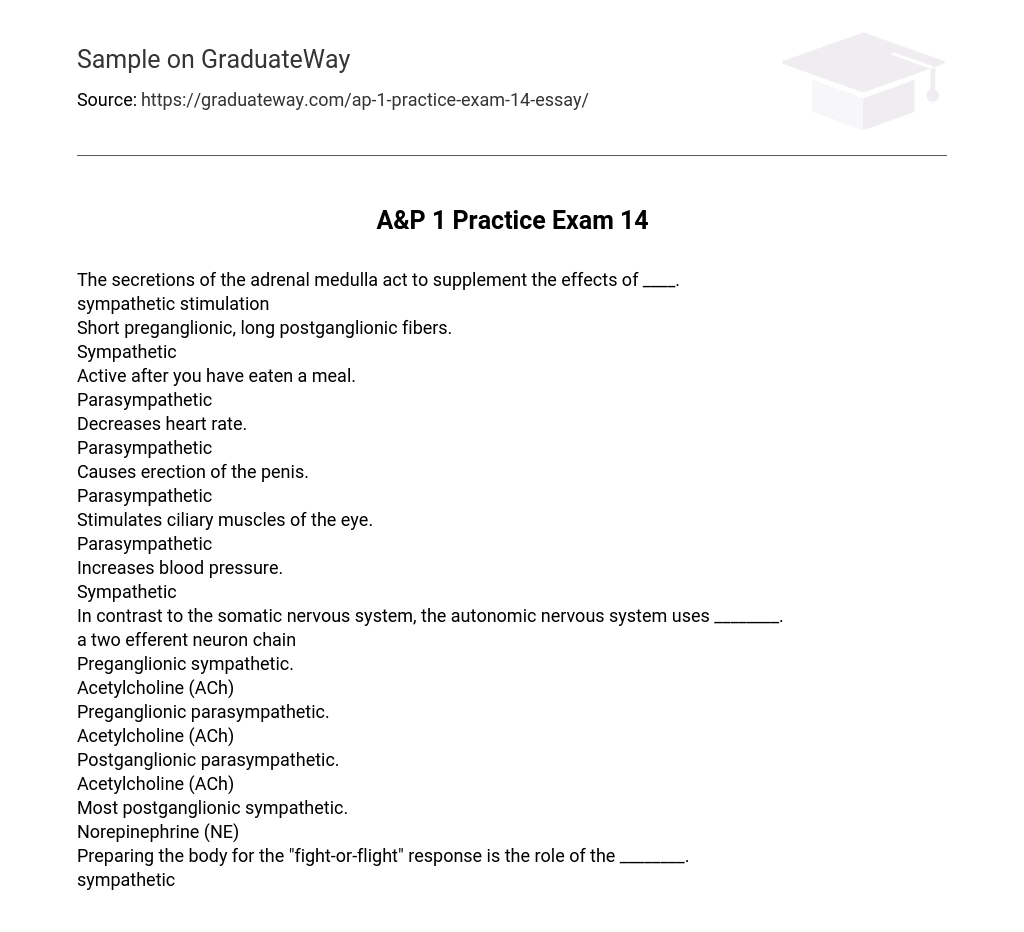The secretions of the adrenal medulla act to supplement the effects of ____.
sympathetic stimulation
Short preganglionic, long postganglionic fibers.
Sympathetic
Active after you have eaten a meal.
Parasympathetic
Decreases heart rate.
Parasympathetic
Causes erection of the penis.
Parasympathetic
Stimulates ciliary muscles of the eye.
Parasympathetic
Increases blood pressure.
Sympathetic
In contrast to the somatic nervous system, the autonomic nervous system uses ________.
a two efferent neuron chain
Preganglionic sympathetic.
Acetylcholine (ACh)
Preganglionic parasympathetic.
Acetylcholine (ACh)
Postganglionic parasympathetic.
Acetylcholine (ACh)
Most postganglionic sympathetic.
Norepinephrine (NE)
Preparing the body for the “fight-or-flight” response is the role of the ________.
sympathetic nervous system
The parasympathetic nervous system is characterized by peripheral ganglia usually near the ________.
organs and by short postganglionic fibers
A drug that might be used specifically to reduce heart rate in cardiac patients could be ________.
a beta-blocker
The parasympathetic ganglion that serves the eye is the ________.
ciliary ganglion
Cardiovascular effects of the sympathetic division include all except ________.
A) dilation of the vessels serving the skeletal muscles
B) dilation of the blood vessels serving the skin and digestive viscera
C) increase of heart rate and force
D) constriction of most blood vessels
B) dilation of the blood vessels serving the skin and digestive viscera
Over 90% of all parasympathetic fibers are derived from cranial nerve number ________.
A) V B) VII C) XII D) X
D) X
The “resting and digesting” division of the autonomic nervous system is the ________.
parasympathetic division
Control of temperature, endocrine activity, and thirst are functions associated with the ________.
hypothalamus
Which of these effectors is not directly controlled by the autonomic nervous system?
A) smooth muscle B) most glands C) skeletal muscle D) cardiac muscle
C) skeletal muscle
Which of the following is not a result of parasympathetic stimulation?
A) increased peristalsis of the digestive viscera
B) salivation
C) dilation of the pupils
D) elimination of urine
C) dilation of the pupils
The site of origin of the preganglionic fibers of the parasympathetic nervous system is the ________.
brain stem and the sacral region of the spinal cord
Sympathetic responses generally are widespread because ________.
NE and epinephrine are secreted into the blood as part
The parasympathetic fibers of the ________ nerves innervate smooth muscles of the eye which cause the lenses to bulge to accommodate close vision.
oculomotor
The parasympathetic tone _____.
determines normal activity of the urinary tract
Beta-blockers ________.
decrease heart rate and blood pressure
Erection of the penis or clitoris ________.
is primarily under parasympathetic control
Which is a uniquely sympathetic function?
A) regulation of cardiac rate
B) regulation of respiratory rate
C) regulation of pupil size
D) regulation of body temperature
D) regulation of body temperature
Raynaud’s disease ________.
is characterized by exaggerated vasoconstriction in the extremities.
Autonomic dysreflexia ________.
involves uncontrolled activation of autonomic neurons
In Horner’s Syndrome ________.
damage to the sympathetic trunk causes loss of ability to sweat on one side
In aging, autonomic inefficiency is often due to ______.
clogging of preganglionic axon terminals with filaments
Sympathetic fibers leave the spinal cord in the ________.
thoracolumbar region, and the postganglionic fibers secrete norepinephrine.
Sympathetic division stimulation causes ________.
increased blood glucose, decreased GI peristalsis, and increased heart rate and blood pressure
The smooth muscle of the digestive viscera is served largely by the ________.
tenth cranial nerve
The route of major parasympathetic outflow from the head is the ________.
vagus nerve
Parasympathetic functions include ________.
lense accomodation for close vision
All preganglionic axons of the autonomic nervous system release ________.
the same transmitter as the one released by parasympathetic postganglionic axons
Emotions influence autonomic reactions primarily through integration in the ________.
hypothalamus
The vagus nerve does not innervate the ________.
parotid gland
Remember! This essay was written by a student
You can get a custom paper by one of our expert writers
Order custom paper
Without paying upfront





